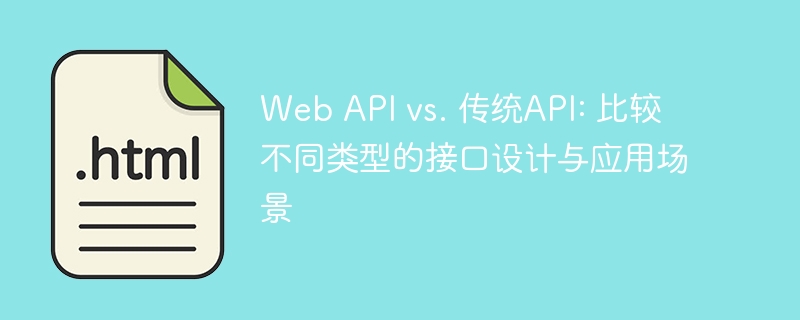

Web API vs. Traditional API: Comparing different types of interface designs and application scenarios
Introduction:
In software development, application programming interface (API) Plays an important role in different application scenarios. With the rise of Web applications, Web API, as a new interface design method, has many significant differences compared with traditional APIs. This article will compare the differences between Web API and traditional API, and use specific code examples to demonstrate their application in different application scenarios.
1. Differences in interface design
1.1 Characteristics of Web API
Web API is an interface design method that uses HTTP protocol as the communication protocol. It uses Uniform Resource Identifiers (URIs) to represent resources and operates on these resources through HTTP methods (GET, POST, PUT, DELETE, etc.). Web APIs usually return data in JSON or XML format to facilitate interaction with front-end pages.
Sample code:
from flask import Flask, jsonify, request
app = Flask(__name__)
@app.route("/api/users", methods=['GET'])
def get_users():
# 获取用户列表
users = [{'name': 'Alice', 'age': 25}, {'name': 'Bob', 'age': 30}]
return jsonify(users)
@app.route("/api/users", methods=['POST'])
def add_user():
# 添加用户
user = request.get_json()
# 处理用户数据
# ...
return jsonify({'message': 'User added successfully'})
if __name__ == "__main__":
app.run()1.2 Characteristics of traditional API
Traditional API usually designs interfaces through function calls or object method calls. They usually use specific data structures (such as arrays, dictionaries, etc.) to pass parameters and return results. Traditional APIs are available in a variety of programming languages, and detailed documentation is often provided on how to use and call these APIs.
Sample code:
class Calculator:
def add(self, a, b):
return a + b
def subtract(self, a, b):
return a - b
# 使用传统API的方式调用
calculator = Calculator()
result = calculator.add(10, 5)
print(result) # 输出:152. Differences in application scenarios
2.1 Application scenarios of Web API
Since Web API uses HTTP protocol as the communication protocol, it is more suitable for Build distributed systems across networks. Web API can be accessed through the network and can be accessed by different client applications, such as web applications, mobile applications, desktop applications, etc. Web API can also implement a microservice architecture, and different services can interact by calling the APIs of other services.
Sample code:
// 前端页面通过Web API获取用户列表
fetch('/api/users')
.then(response => response.json())
.then(data => {
// 处理数据
// ...
})
.catch(error => {
// 处理错误
// ...
});2.2 Application scenarios of traditional API
Traditional API is usually used for the development of single applications or local applications. Since the traditional API is called directly within the program, it is more suitable for the development of a single application. Traditional APIs can provide more complex and flexible functions and can easily operate data structures in memory, such as arrays, dictionaries, etc.
Sample code:
# 在本地应用程序中调用传统API calculator = Calculator() result = calculator.add(10, 5) print(result) # 输出:15
Conclusion:
Web API and traditional API are obviously different in interface design and application scenarios. Web API uses the HTTP protocol for communication, which is suitable for building distributed systems across the network and can be accessed by different client applications through the network. Traditional APIs are usually used for the development of monolithic applications or local applications, and can provide more complex and flexible functions. In practical applications, we can choose a suitable interface design method according to specific needs.
The above is the detailed content of Compare the interface design and application scenarios of Web API and traditional API. For more information, please follow other related articles on the PHP Chinese website!
 What are the main characteristics of computers?
What are the main characteristics of computers?
 Ripple trading platform
Ripple trading platform
 What are the common testing techniques?
What are the common testing techniques?
 How to use imfinfo function
How to use imfinfo function
 The computer has Internet access but the browser cannot open the web page
The computer has Internet access but the browser cannot open the web page
 How to set up domain name redirection
How to set up domain name redirection
 Which platform is better for virtual currency trading?
Which platform is better for virtual currency trading?
 The most promising coin in 2024
The most promising coin in 2024




